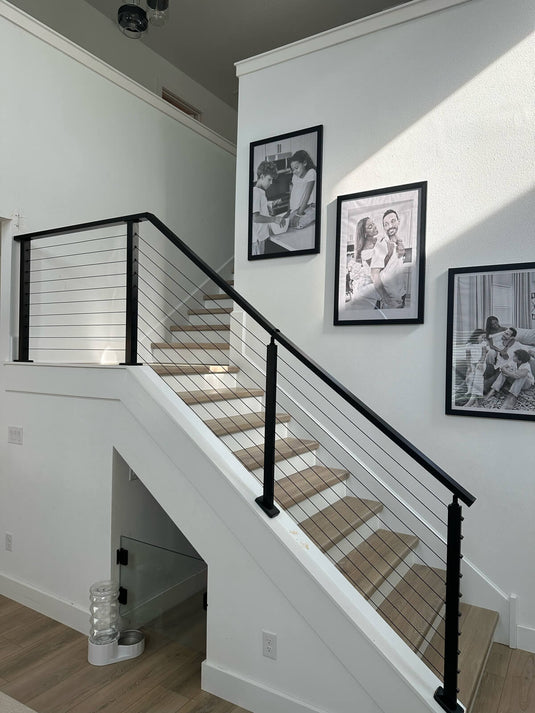TABLE OF CONTENTS
How to Choose Cable Railing Systems to Save Space?
In modern residential architecture, optimizing square footage is an essential consideration. As urban housing densifies and floorplans shrink, creative spatial solutions become imperative. Installing cable railing systems is an ingenious way to visually expand cramped interiors and exteriors. With slender cables and translucent posts, these graceful minimalist railings foster an illusion of increased spaciousness. When designing a balcony, deck, staircase, or other area, choosing a cable railing style can enhance the perception of roominess. Evaluating the space-saving attributes and trade-offs of metal, wood, and aluminum cable rail systems allows for an educated selection.
The Innate Space-Saving Qualities of Cable Railing Systems

Fundamentally, cable railing systems incorporate taut horizontal cables extended between discreet vertical posts. This simplified construction stands apart for its lightweight, see-through aesthetic versus chunky wood or metal railings. The sheer transparency enables unbroken sightlines, imparting a feeling of openness to the space. The slender cables claim minimal visual real estate, boosting the apparent square footage.
Additionally, cable railings necessitate less physical space than other railing types. The posts inhabit a modest footprint, omitting the area consumed by a lower rail. Devoid of bulky bottom and mid rails, the view remains unencumbered. The entire minimalist look also elicits a brighter, less cluttered ambiance. For snug balconies, decks, and comparable settings, the space-enhancing illusion and compact composition of cable railings are ideal.
Metal Cable Railing Systems: Augmenting Vistas and Area

For an industrial-inspired look that capitalizes on panoramas and usable area, metal cable rails are an optimal choice. Refined stainless steel and aluminum are prevalent, providing extreme endurance and visual slimness. The posts frequently incorporate elementary bar forms that integrate into the surroundings.
With merely slim cables and small posts placed intermittently, metal systems furnish ideal transparency. The cables can be positioned at intervals to satisfy building codes while maintaining the deception of spaciousness. This accommodates unimpeded views of the scenic landscape, making a balcony or deck feel more expansive. The hardy metal materials also resist weathering, securing the lasting use of the space.
On the whole, metal cable railings epitomize the space-enhancing effect that cable systems provide. The style is an astute solution for stairwells, balconies, walkways, and decks requiring a space-saving approach.
Wood Cable Railing Systems: Uniting Tradition and Space Optimization

For a warmer, organic aesthetic, wood cable railings balance timeless elegance with space efficiency. Decorative wood posts contribute a classic flair. Yet the gossamer cables still maximize the perception of roominess. Designs may integrate wood handrails or top rails while employing cable infill.
Relative to solid wood railings, combining wood posts with cable infill significantly improves the vistas. The eye can readily gaze past the cables to appreciate the surroundings, upholding that feeling of spatial generosity. Using naturally durable species like cedar can impart graceful longevity. Properly sealed and maintained, wood cable railings furnish safety with an ageless charm.
Overall, wood cable railings cultivate the deception of expanded areas while conveying rich craftsmanship. The look strikes a subtle balance between coziness and minimalism.
Aluminum Cable Railing Systems: Refined and Compact

Industry-leading cable railing fabricators offer aluminum systems as another lightweight yet robust possibility. Aluminum is accessibly priced, naturally oxidation-resistant, and lighter than other metals. The decreased weight enables straightforward installation in settings like balconies without burdensome structural reinforcement.
When engineering spaces are mindful of area constraints, aluminum cable railings confer advantages. The modest weight and polished silver coloring maintain a streamlined, inconspicuous system. With properly tensioned cables, the railing becomes nearly invisible, receding optically to maximize square footage. Aluminum can be readily powder-coated in an array of hues to blend with the locale, preserving discretion.
On the whole, aluminum systems proffer benefits like weather resistance, visual compactness, and simplified installation. For budget-conscious projects seeking to expand functional space, aluminum cable railings warrant consideration.
Key Criteria for Selecting a Space-Optimizing Cable Railing

When selecting a cable railing system, maintaining spatial efficiency should be the foremost objective. Contemplate these vital factors:
●Profile and Design – More streamlined post, cable, and fitting designs are less obtrusive to the eye. Uncluttered, straightforward designs perpetuate the illusion of expansive space. Opt for elementary forms and minimal accessories.
●Transparency – Cables separated at optimal intervals allow for unbroken sightlines, magnifying the perception of the area. Evaluate cable spacing and gauge for ideal see-through visibility. Wider spacing and thinner cables enhance transparency.
●Material Suitability – Verify the materials are impervious to the locale's conditions like weather, wear-and-tear, and building codes. The proper structural materials guarantee enduring spatial openness without sagging or replacement.
●Post Style – Choose post designs that recede into the surroundings for a lightweight look. Thinner post profiles occupy less visual real estate. Minimalist post shapes like thin rectangles enhance transparency.
●Cable Tension - Proper tensioning keeps cables shapely and taut. Cables should have only minor flex when force is applied. Optimally, taut cables maximize spaciousness.
Installation Techniques for Space Optimization
Specialized installation is indispensable for actualizing a cable railing's space-saving potential. Inexpert tensioning or anchoring can lead to sagging cables, compromising safety and perceived spaciousness. Qualified installers also aptly space posts and cables to maintain lightness and sightlines.
Ongoing maintenance upholds the minimalist aesthetic over time; sagging cables can clutter vistas. Annual inspection and tension tuning sustain crisp cable lines. Prompt dent repair and post replacement preclude bulky repairs that congest space.
With meticulous installation and care, cable systems uphold their subtle presence, keeping the space visually uncluttered for years. Clean cable lines also boost perceived safety. Overall, proper implementation begets the full spatial and aesthetic benefits.
Conclusion
For modern interior and exterior settings where space is scarce, cable railing systems furnish an elegant solution. The intuitive integration of diaphanous cables and streamlined posts manufactures an illusion of expanded spaciousness. Metal, wood, and aluminum options enhance vistas and usable areas with modest profiles. When planning railings for compact balconies, stairwells, and decks, cable systems boost safety while maximizing perceived spaciousness. Adopting design and installation best practices empowers homeowners and designers to enjoy these space-saving payoffs long-term. With their understated minimalist form, cable railings supply dimensionality alongside contemporary flair.




